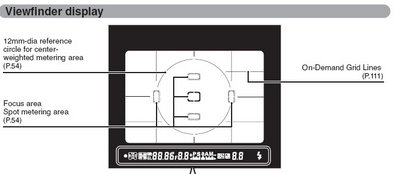How To Focus Your Camera

All too often, a novice photographer will buy the latest and greatest in equipment, only to be disappointed and disillusioned when the brand-new digital single lens reflex (SLR) or super point and shoot camera makes images that are out of focus and no better or worse than the cheap digital camera they used before. It can be frustrating to get out of focus shots, but there's a few things a new camera owner needs to know about how to properly focus a camera to get the best results.
Let's focus first on SLR cameras, which allow the photographer to view through the lens to compose and focus. In the illustration above, a typical SLR viewfinder is shown. In this case, it's from the Fujifilm S3pro. Note that there are marked focus areas displayed in the viewfinder, and that the selected focus area in the center is highlighted. What a novice will often do is just center the subject in the viewfinder, then release the shutter. However, if the subject isn't under the selected, active focus point, then the camera will focus incorrectly and the photographer will end up with an out of focus shot. I've seen it a lot with shots of couples--the camera will focus directly between the two people and lock onto something in the background.
So when focusing with any camera, the things to remember are:
- Make sure your subject is actually in focus. Don't just point and shoot. Look at the viewfinder; if the subject is out of focus, your image will be out of focus.
- Focus on the eyes! I can't stress this one enough. A photograph where the person has sharp eyes naturally appears sharper than a photo where the nose is in perfect focus but the eyes are blurry. And once you've got the eyes in focus, lock the focus in place by keeping the shutter release partially depressed as you recompose.
- Lock the focus, then recompose! I've seen people actually focus on the eyes, but fail to lock the focus. Typically, by keeping the shutter release partially depressed, the focus is locked, and you can recompose to put the subject where you want in the frame. If you don't lock the focus, then when you release the shutter, the camera will re-focus--on the wrong area!
- The focus areas are rough guides. Don't rely on the markings to accurately define the sensitive area of the focus unit. The sensor may actually be slightly above, below, or to one side of the marked area, and you'll have to experiment to see where the sensor(s) focus best. Note that on point and shoots, the focus area may be unmarked; the sensor is usually in the center though.
- Use the most sensitive focus sensor. Focus sensors come in three main types: vertical, horizontal, and cross sensors. They utilize contrast to determine focus. Cross sensors can sense both horizontal and vertical lines, so they are the most sensitive. Typically, they are used for the "center" focus area. Check your manual; more expensive cameras may have a lot more cross sensors. Otherwise, use the center sensor--it's your best best for a focused shot.
Okay, now that you've got that down, you're all set, right? No! Proper focusing also includes thinking about a more complex subject called depth of field which in simplest terms is the area that's in focus in front and behind the area you've immediately focused on. Depth of field is affected by your lens opening, called an aperture. The bigger the lens opening, the more "shallow" the depth of field; less area will be in focus in front of and behind the subject. That may be fine if you're only focusing on one person, but it can mean an out of focus shot if you're photographing a family, a group, or a landscape. The solution is to select an aperture that will ensure sufficient depth of field to get what you want in focus.
What about point and shoot cameras? Luckily, their sensors are smaller which means that the images naturally have more depth of field. They do have focus sensors, usually just one sensor in the center of the image. And again, typically depressing the shutter release part way will lock the focus, allowing the photographer to re-compose. So for point and shoot users, remember to focus on the eyes, lock the focus, and recompose before releasing the shutter. The smaller sensor should in most cases give you sufficent depth of field--which, when matched with the strong sharpening routines in a point and shoot, is why point and shoot digital cameras often look "sharper" than a shot with a digital SLR.
Besides improper focusing, another cause of out of focus shots is vibration and/or motion blur. What this means is that your subject moved or the camera moved or vibrated during the exposure. That's a subject for a whole new post, but the short answer is: choose a shutter speed that is sufficient to prevent blur from motion or vibration; or use a flash; or use a tripod.
A few simple steps will increase your percentage of "keepers" tremendously. Practice good technique and the good images will follow.
1 Comments:
zzzzz2018.8.2
nike shoes for women
moncler online outlet
oakley sunglasses
manolo blahnik
coach outlet
adidas nmd
oakley sunglasses wholesale
air jordan 4
polo lacoste
christian louboutin outlet
Post a Comment
<< Home